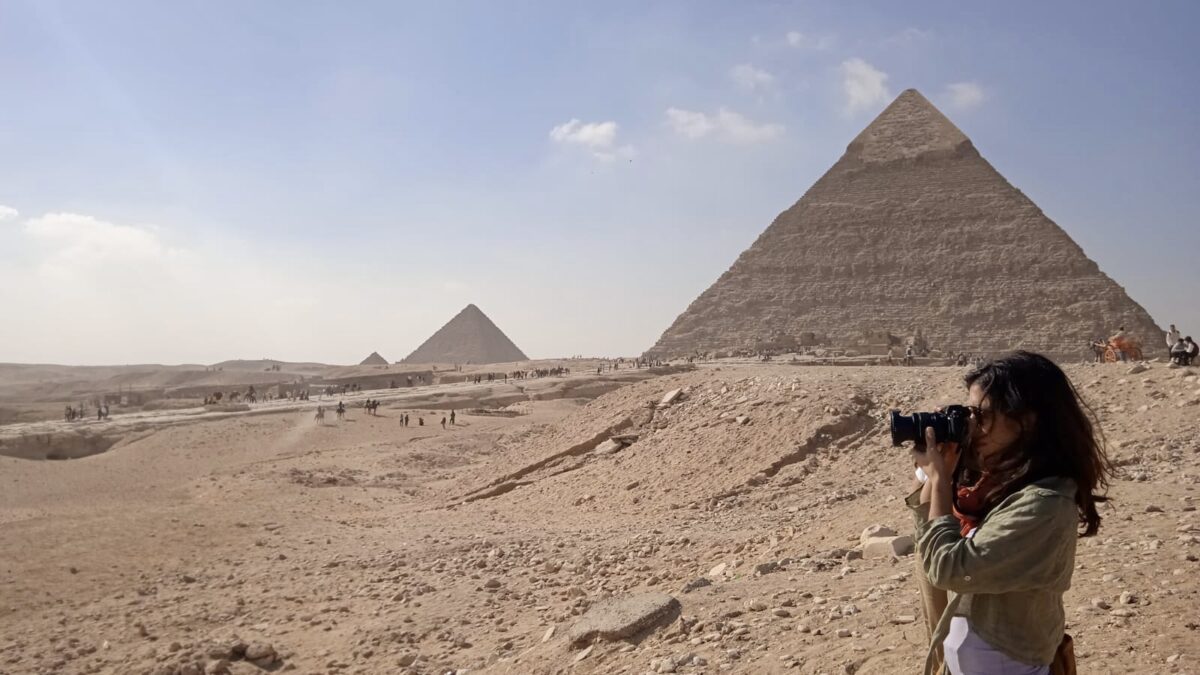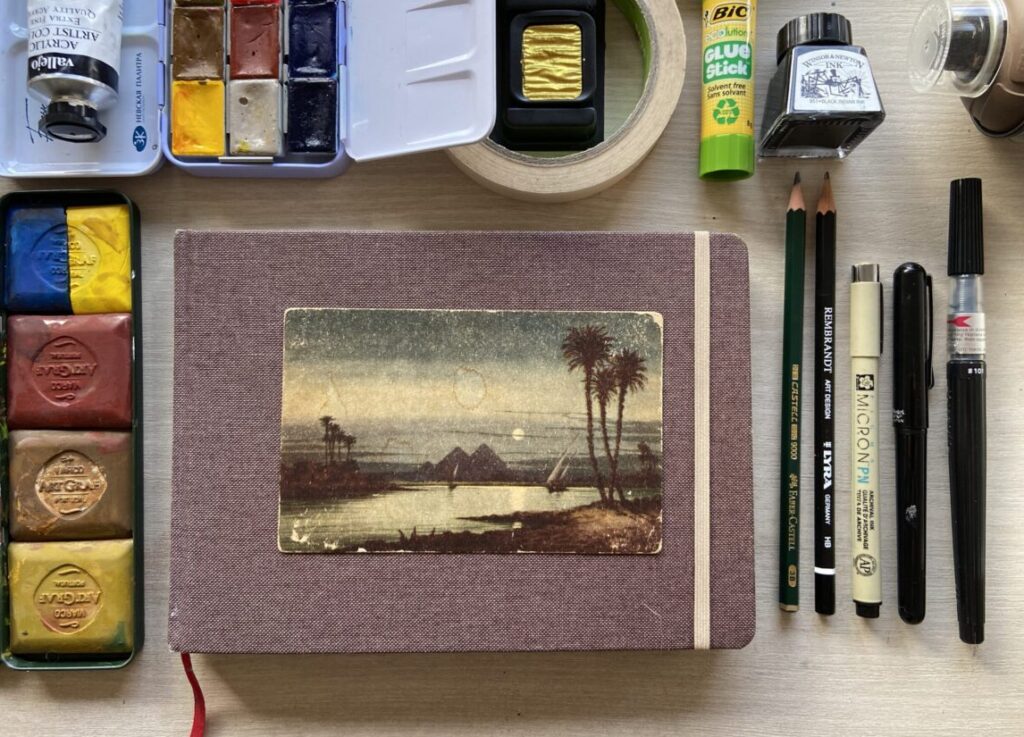
When it comes to talking about cultural heritage and tourism, what better place than Egypt. I travelled to this country of millenary tradition with the intention of approaching its culture through painting. To do so, I took up the unusual proposal of the artist Paula Bonet and the agency Viatges acompanyats.
Paula proposes, through the Taller la Madriguera, a workshop trip during which a travel diary is created. The intention is to develop your own artistic and creative abilities, and also a new way of looking at the world around you, all within the framework of a group trip.
EGYPT AND TOURISM IN CONTEXT
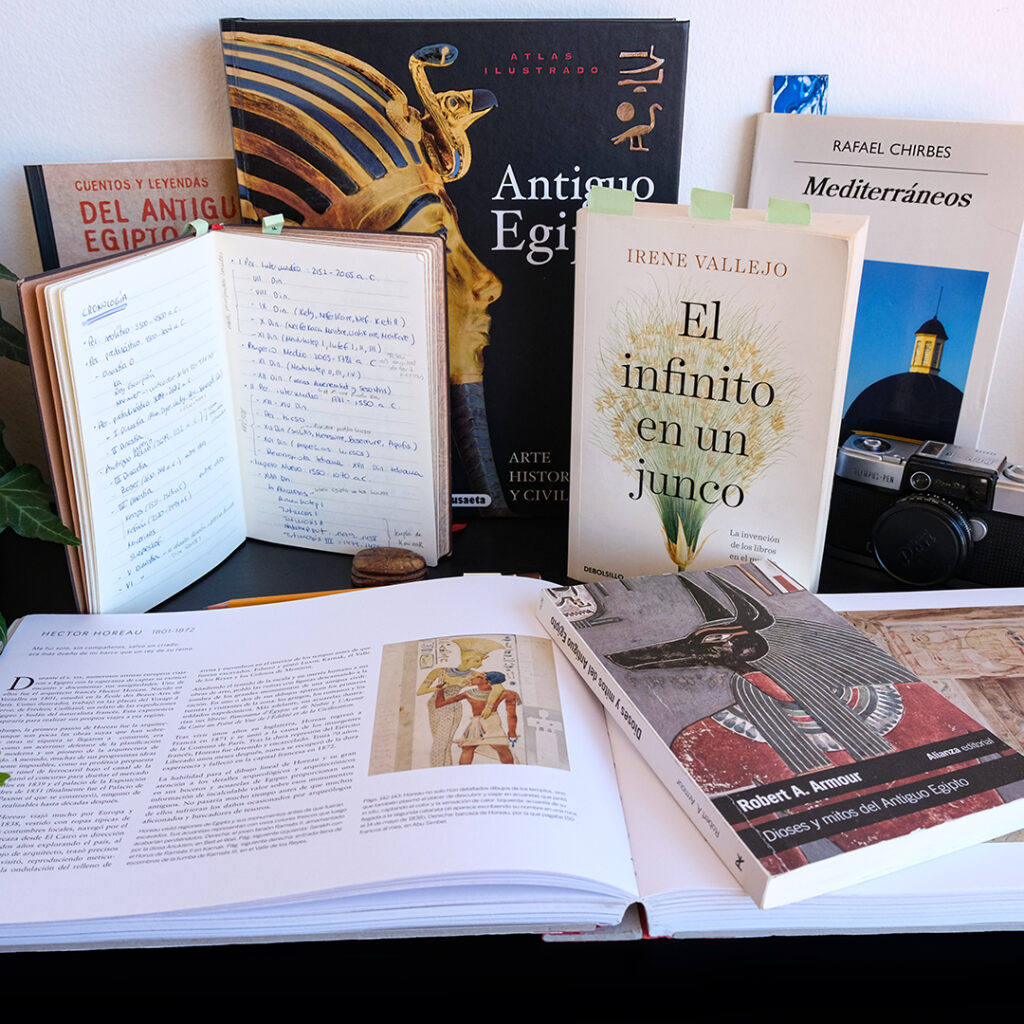
I arrived at Barcelona airport ready to embark for Luxor with my homework done. Without a doubt, this is one of the trips that I have prepared the most before starting it. I could not arrive in the land of the pharaohs without being able to distinguish generaly the different periods of Ancient Egypt, without first ordering the numerous dynasties in my head and the vast wealth of Egypt’s cultural heritage.
I was helped in this task by the abundant bibliography that exists, but above all by Nacho Ares’ wonderful podcast Inside the Pyramid. These podcasts of less than an hour are produced with great care: the extensive knowledge of historian and Egyptologist Nacho Ares is shared in a clear and entertaining way, and easily transports the listener to Ancient Egypt.
Decline and recovery
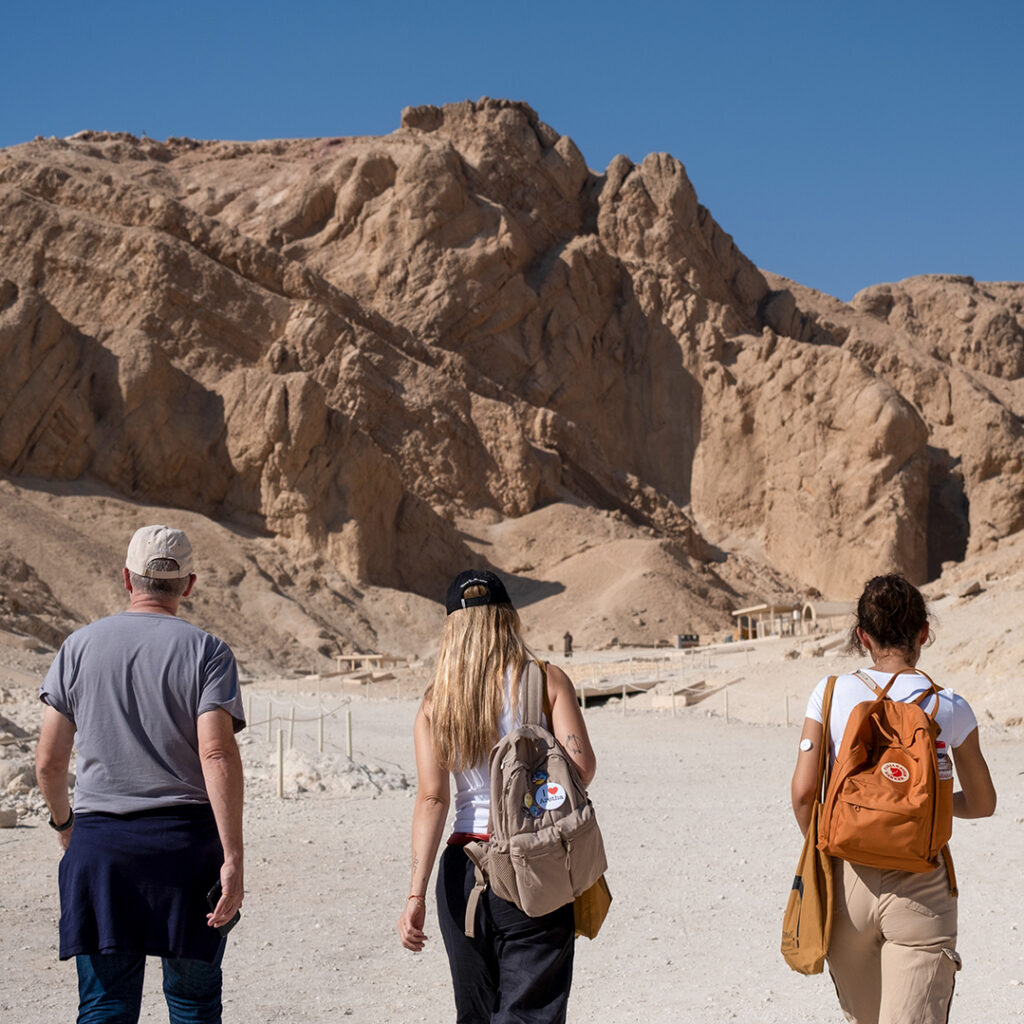
During this period, I not only learned about the country’s culture, but also about its tourism.
Egypt has historically been a major tourist destination, but it’s been greatly affected by the continuing insecurity caused by terrorism. Attacks against tourists have greatly weakened this economic mainstay of the country, especially in the 1990s and after the Arab Spring (which began with the conflicts of 25 January 2011 and is known as the Egyptian Revolution).Tourism plummeted after these events and did not start to recover slightly until 2019, before being paralysed again by the pandemic (UNWTO data).
In this context, it’s particularly encouraging for Egyptian tourism to see the recovery data after the restrictions imposed by the Covid-19 health crisis. According to the UNWTO, in September 2022 «arrivals exceeded pre-pandemic levels in the Middle East (+3% compared to 2019)».

In Spain, bookings to Egypt in summer 2022 were much higher than before the pandemic. What’s more, Egypt is the country that has increased the most as a tourist destination in Spain compared to pre-pandemic data (+81%).
National Geographic called 2022/23 «a fabulous time to visit Egypt», referring to the upcoming opening of the Grand Egyptian Museum (GEM) and the already inaugurated Mummy Room at the National Museum of Egyptian Civilization (NMEC). We should not forget that 2022 is also the centenary year of the discovery of Tutankhamun’s tomb by Howard Carter.
HERITAGE AND ART IN MODERN EGYPT
Egypt is home to an ancient cultural heritage that will amaze you wherever you go. The various civilisations that have succeeded each other in this country have enriched its legacy, and one of the first things you notice is the crossroads of traditions.
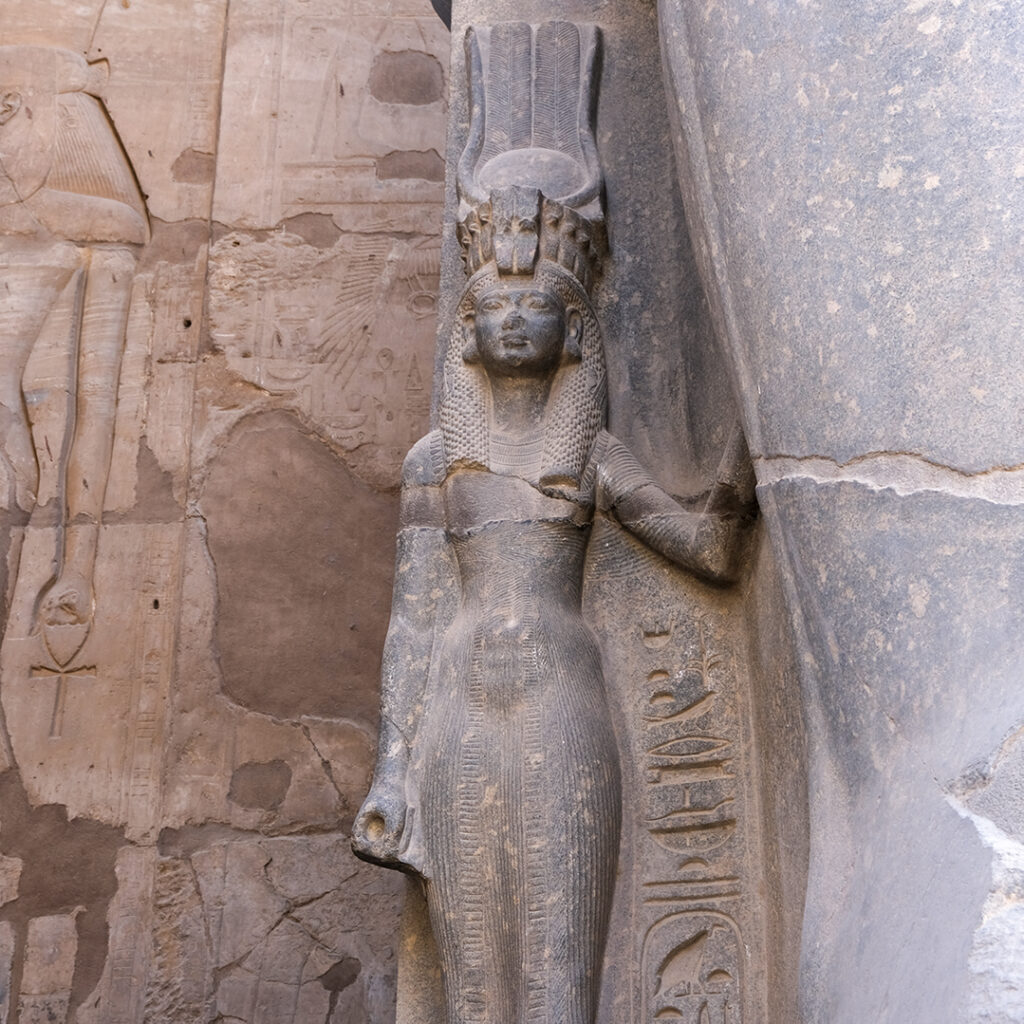
Pharaoh Ramses II, Temple of Luxor
Usually, one travels to Egypt expecting to be moved by the Great Pyramids of Giza or the tombs of the Valley of the Kings, and of course this is a guaranteed experience amidst the dust and sand of its deserts. However, upon arrival at these historic sites, visitors immediately feel the gap that separates them from the Ancient Egypt of Pharaoh.
Actually, one of the most difficult things is to be able to transport oneself back in time and project oneself into that era. It’s hard to understand the contextual difference and not to read what we are seeing from a presentism, applying our modern conception of the world to these civilisations.
To realise that between the construction of the Great Pyramid of Cheops, one of the 7 wonders of the ancient world, and the extraordinary temple of Hatshepsut, there are about 1000 years of historical development.
From our contemporary, western gaze, we admire the grave goods of Tutankhamun’s tomb and, a few metres later, the portraits of El Fayum in the Egyptian Museum, and we must make an effort to place them both in Pharaonic Egypt, although the former is part of the New Empire and the portraits are from the much later Roman period.
THE PAPER THAT BLOOMS FROM THE NILE
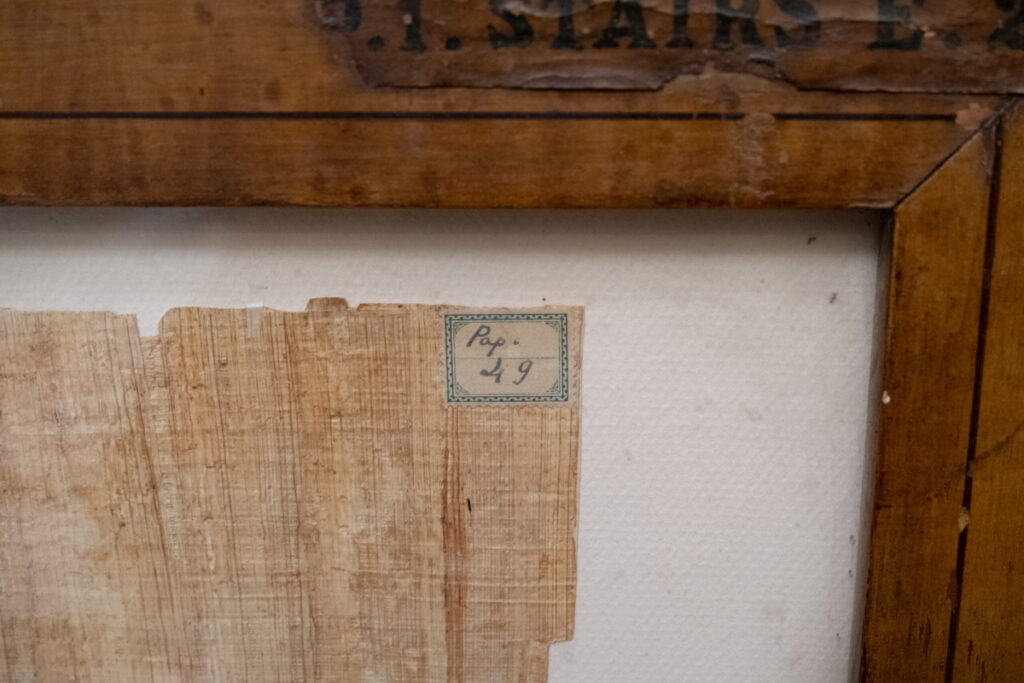
One of Egypt’s great contributions to the world’s cultural heritage was papyrus. The Egyptians saw that the papyrus reeds that grew in the Nile could be used to create sheets suitable for writing, a material that they exported for centuries to the Middle East.
Irene Vallejo tells us in El infinito en un junco that «after centuries of searching for supports and human writing on stone, clay, wood or metal, language finally found its home in living matter. The first book in history was born when words, barely written air, found shelter in the marrow of an aquatic plant».
Manuscripts in the Egyptian Museum in Cairo
When, walking through the Egyptian Museum in Cairo, I came to the «Manuscripts writing materials» room and found myself alone in this space full of papyrus, I was moved by the beauty of this ancient writing. Afterwards, in the museum shop, I had the opportunity to buy a papyrus paper notebook, on which I was able to try the technique used by the ancient Egyptians -egg tempera-, with an indigo pigment bought in the Cairo souk.
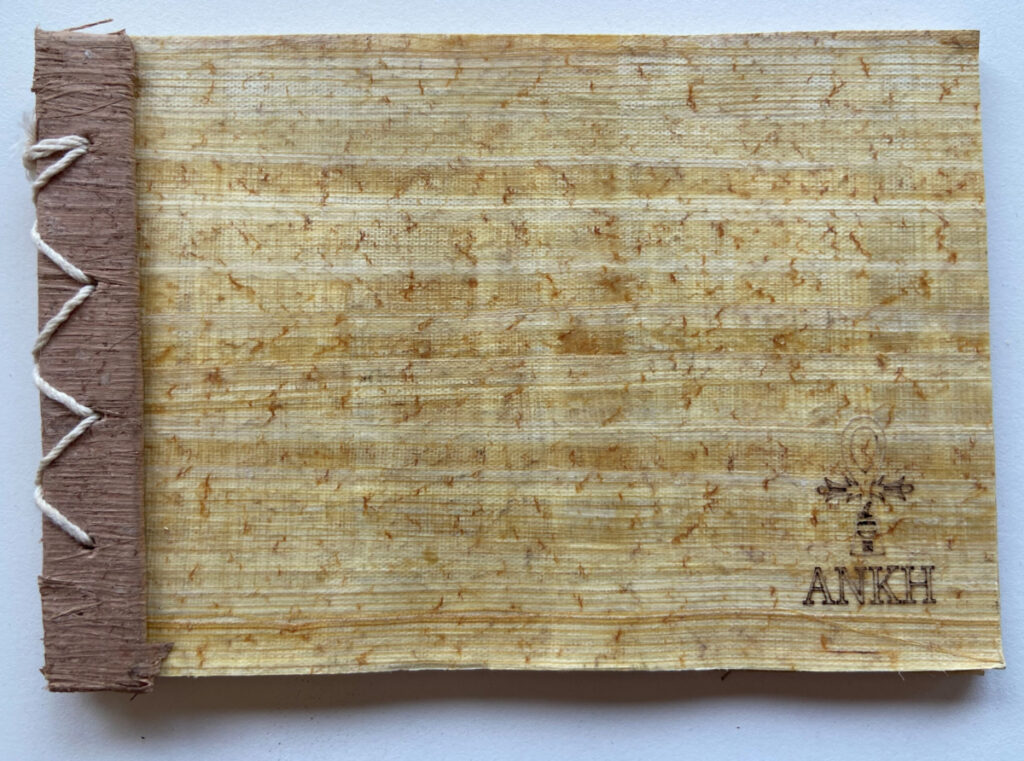
Ever since I was a child I have felt that strange pleasure in holding a book in my hands, that kind of fetishism for the object of the book, that love of going into bookshops and libraries wherever I go. That’s why in my article on Japan you can also read about its traditional Washi paper and Tokyo’s bookshop district.
Egypt was not only the place where papyrus was invented, but also home to the most important library of antiquity: the Library of Alexandria.
I flew to Egypt in the hope that the Great Egyptian Museum (GEM) would be open on our arrival and, to my surprise, I couldn’t have been happier that it wasn’t from the very moment I entered the ramshackle, dusty Egyptian Museum. Looking at those shattered glass cases, some already empty, I felt that these relics of the past belonged there rather than in a new, sterile, pristine space.
PAINTING A TRAVEL DIARY
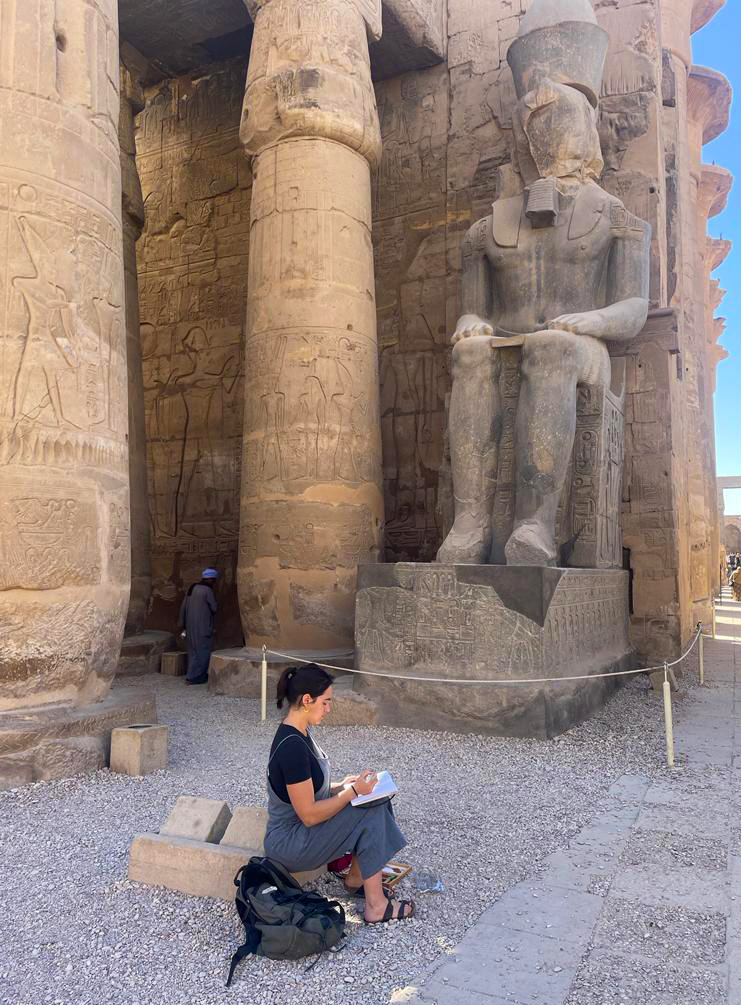
The artistic workshop from Luxor to Cairo allowed me to inhabit the space in a different way, devoting time to conscious observation. Looking at the great monuments of antiquity with a notebook in your hand makes you consider them in a different way, it forces you to observe and study them from a different perspective.
Painting, you travel on the side of the builders and craftsmen. Searching how to approach your drawing, you examine and perceive the paintings of the ancient Egyptians in a different way.
For several millennia, the iconography of Egyptian funerary art imposed stylistic neutrality. The aim was representative homogeneity, not personal creation. Even «pigments in ancient Egyptian painting contribute to reproducing reality by copying it as faithfully as possible» (Anne Varichon, Colours, history of their meaning and manufacture, 2005).
This was only altered during the Amarna period under the reign of Akhenaten (formerly Amenhotep IV), later dubbed «the heretic pharaoh» by Ramesses II. During this period, art acquired a more expressive and original style, free and spontaneous, and images of intimacy beyond the «classical» style appeared.
But as far as the line drawing is concerned, what struck me most during the trip were the sketches that are still preserved in the tomb of Seti I. There we can perceive the outlines and corrections prior to the painting that would go down to posterity.
Painting the past and the present
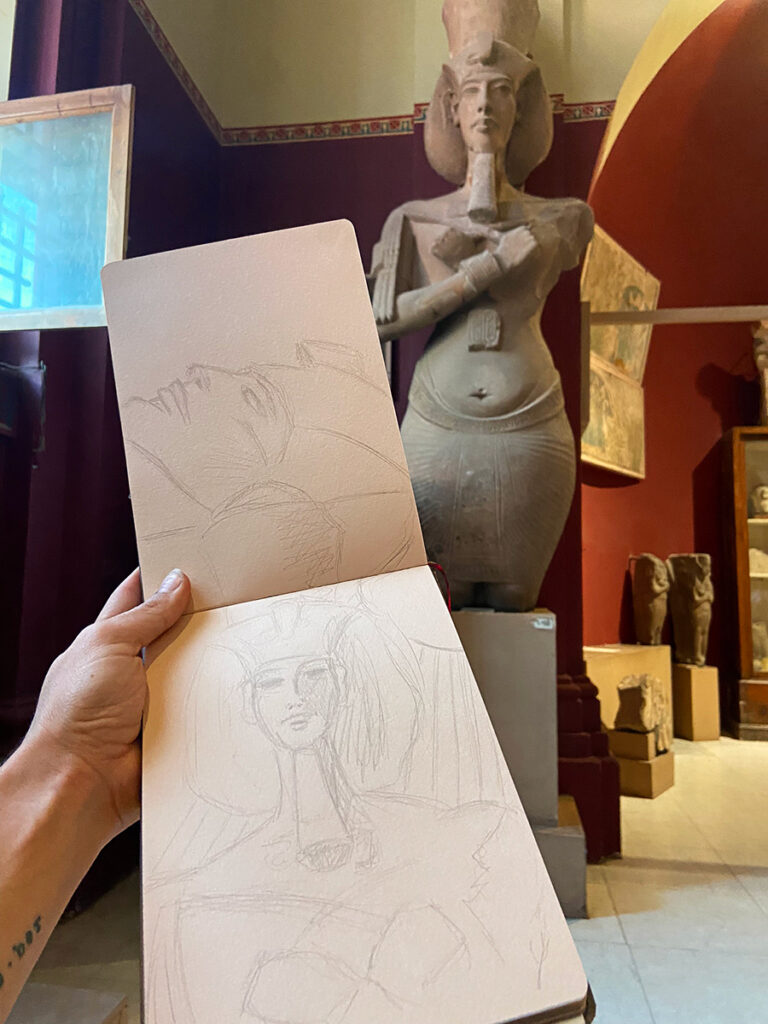
However, painting not only allows us to embrace the past in a different way, but also the present. By portraying the people living in Egypt today, the bar of the hotel where we stayed, its streets and its souks, I had experiences beyond painting.
The complicity that was generated with the waiters at the Winter Palace bar and their curiosity to see the result would not have existed if I had not taken out my sketchbook to paint on the bar.
When we sat on the dusty floor of the Temple of Karnak and painted an Egyptian woman who was passing by and wanted to pose for us, we were able to share a pleasant moment with her without having to speak the same language (see video).
EGYPT AND SUSTAINABILITY
Before I went to Egypt, I had been researching the country’s involvement in sustainable tourism. Shortly before my arrival, Egypt had hosted the COP27 (United Nations Climate Change Conference) from 6 to 18 November 2022. The event took place in the coastal city of Sharm el-Sheikh and, after the negotiations, it quickly became clear that the results were insufficient.
While it was agreed to establish a fund to help the most vulnerable countries, it is not clear how it will be distributed, nor is it accompanied by other strong and effective measures (see more details). In fact, the very location of the conference could be seen as a metaphor for the incongruities of the fight against climate change: Sharm el Sheikh is a resort town full of hotels with large swimming pools in the middle of the desert, on the coast of a country suffering from severe water poverty, in the middle of Africa, the continent most affected by climate change.
Although the contrast between Egypt’s social and environmental deprivation and the comforts of hotels and resorts is stark, it’s worth highlighting some of the development projects that are being pursued as part of the Ministry of Tourism and Antiquities’ sustainable development strategy and Egypt’s Vision 2030. For example, the Grand Egyptian Museum is being sought to become the country’s first sustainable museum, with all buildings being constructed as ‘green’.
There is still a long way to go
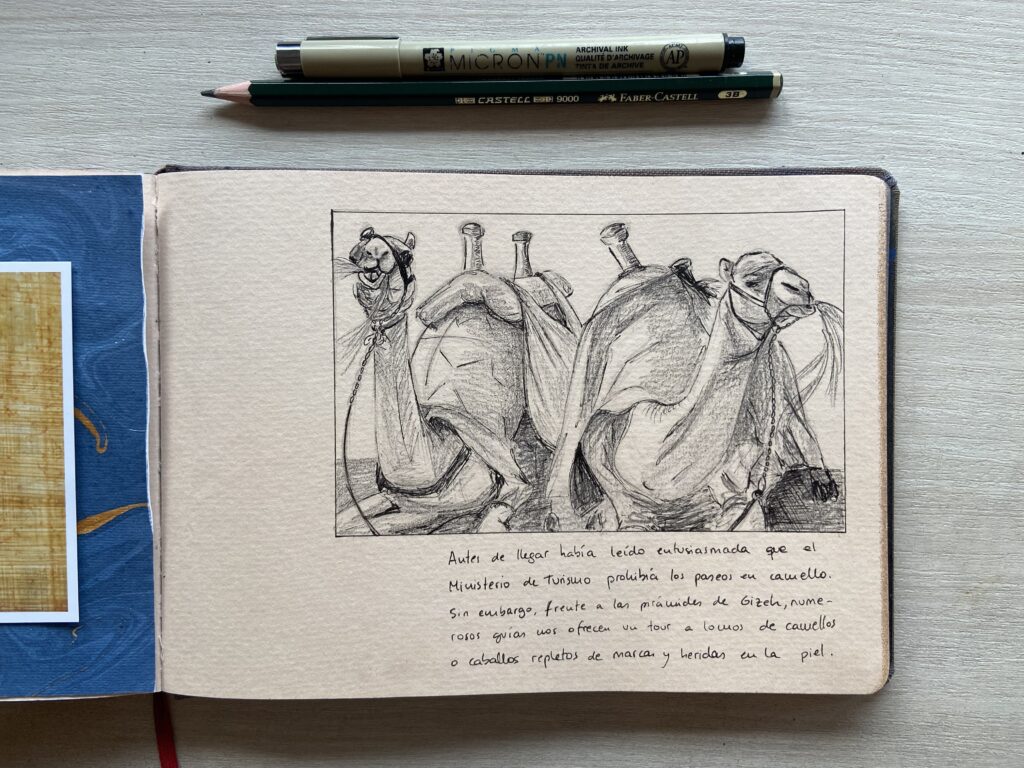
Unfortunately, not all the news is good news. In 2020, the Ministry of Tourism announced that camel and horse rides would be banned in Giza, following PETA Asia’s 2019 investigation into the mistreatment of these animals.
I expected to find these four-footed animals enjoying good conditions in the archaeological site of the pyramids in December 2022, but on arrival I found that they were still being offered to tourists for a ride, on their backs or in carts, and that they had marks and wounds on their skin.
This led me to look up what had happened to the Ministry’s promise. I found that it has recently informed the PETA group that «they will not provide water and shade for these horses until the second half of 2023». Despite the introduction of some electric vehicles in the area, animal welfare is still not taken seriously. PETA Asia continues to fight for these animals to be treated with dignity and reminds visitors that riding them contributes to their mistreatment.
LAST STOP: EGYPTIAN CUISINE
Something that for me is essential when it comes to getting to know a culture, its people and their way of life, is the food. Their ingredients and recipes define them, as well as their lunch times and gastronomic traditions.
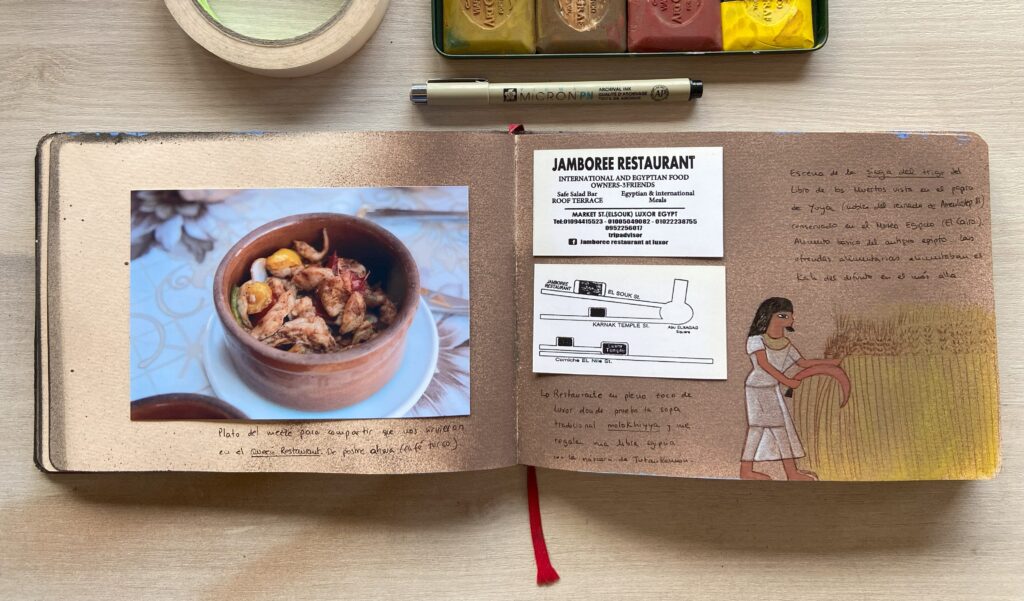
Papyrus, and a photograph of a mezze served in Luxor.
As we have started this journey back in time to Ancient Egypt, it would be good to end it with what we know about the food of pharaohs. Thanks to the funerary art and the food offerings that were recorded on the walls of the tombs and in the papyri, as well as in literary sources such as the writings of Herodotus and the archaeological remains found, we have evidence of the food at that time.
It was a poor diet based on bread and beer, as wheat was a basic element in their diet. The beer was not liquid, but was more like porridge with little alcohol. They also ate fish from the Nile and hunted or farmed poultry.

The olive tree was imported from nearby regions and its cultivation spread during the New Empire. In the paintings of various tombs we can see scenes connected with food, such as the harvesting of wheat, and food offerings for the Ka in afterlife.
Nowadays, Egyptian cuisine includes many pulses (in soup, stewed, fried or in the form of pasta such as the Egyptian falafel ta’amiyya). Of all the things I tried, I definitely loved the jute leaf soup called molokhiyya that I was served at the Jamboree Restaurant, in the Luxor souk. The waiter was especially pleased that I had chosen a traditional Egyptian dish, and showed me the way they eat it: by slicing bread into it.
CONCLUDING A JOURNEY OF EXPLORATION THROUGH PAINTING
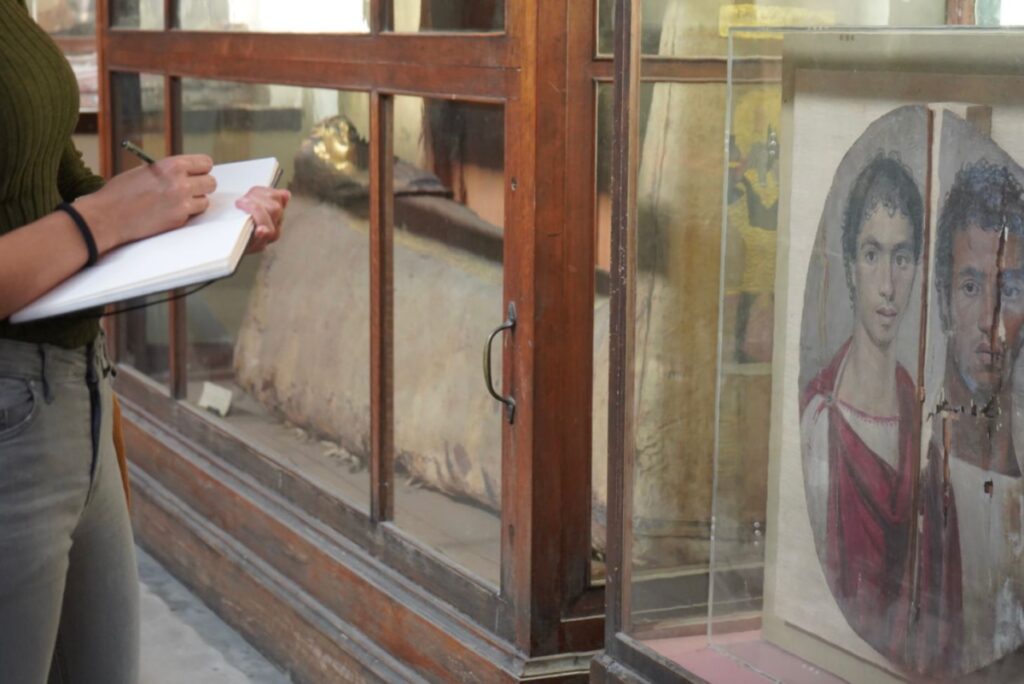
Egypt is a country of contrasts, convulsive, contradictory. My passage through this place of millenary tradition has been rather quick, but I have tried to gather as much as possible about its history, its past and its present.
I thought about what all those archaeologists of the 19th century must have felt when they unearthed countless wonders, which are still great mysteries of humanity today.
What the explorers must have felt, notebook in hand, such as Amelia Edwards, Hector Horeau or David Roberts. Works of these artists allow us to see the lost original colours of places such as the Temple of Déndera.
The explorer Robert J. Flaherty wrote better than I could about this relationship between travel and art:
«Ulysses made his journeys and then Homer wrote about them. Discovering and revealing, that’s how artists work. All artistic expression is, I imagine, a form of exploration.».
Robert J. Flaherty (1949)

